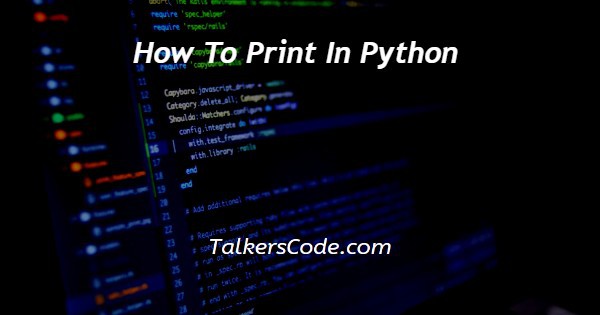In this article we will show you the solution of how to print in python, Programmers utilize printing as a fundamental process because it enables them to show data and output to users. The built-in print() method in Python can be used to print data.
The values you want to see on the console are passed as one or more arguments to this function.
Simply enclose a string in double or single quotes within the parentheses of the print() function to print it.
The + operator can be used to combine multiple strings, and formatted strings can be used to introduce variables or expressions into the text.
You can format your output in Python by adding special characters and escape sequences, such as n for a newline, t for a tab, or to show a backslash
Step By Step Guide On How To Print In Python :-
Method - String Literals
print("Talkerscode \n is best for learning.")
- You can see how we construct Python code that prints in this example.
- Python's "print()" method is used to show output on the console.
- It accepts a string parameter that is wrapped in double quotes and says, "Talkerscode n is best for learning."
- The letter "n" is then used, which is known as a "escape sequence" and stands in for a newline character.
- This results in a new line of text following the phrase "Talkerscode" that reads, "is best for learning."
Method - Use of end= ” ” statement
print ("Talkerscode is the best learning platform")
print ("Talkerscode is the best learning platform", end= "**")
print("Welcome to Talkerscode")
- As you can see, we write the Python code here to produce Python output.
- To display text on the terminal, we use the built-in print() function.
- Printing the string "Talkerscode is the best learning platform" to the console is all that the first line from the code, print("Talkerscode is the best learning platform"), does.
- The newline character at the end of this line signals that a new line will be created for the next line of text.
- The second line of the code then reads like the first line but adds a new parameter to the print() function: print("Talkerscode is the best learning platform", end= "**").
- The output will then conclude with "" rather than the standard newline character thanks to the use of the end option, which is set to "".
- As a result, there won't be a newline character between the third and prior lines of text when they are printed.
- The print() function is then used once more in the third line of the code, print("Welcome to Talkerscode"), to display the string "Welcome to Talkerscode" on the console.
- Because the previous line's default newline character indicates that this line is distinct from the previous line, that will be printed on a new line.
Conclusion :-
As a result, we have successfully acquired the knowledge necessary to print in Python.
Additionally, we discovered that printing is a fundamental idea in Python programming.
There is a quick and effective approach to display output on the console using the print() function.
Python offers a wide range of inbuilt functions and special characters that allow programmers to add variables, expressions, and formatted strings to their output.
I hope this article on how to print in python helps you and the steps and method mentioned above are easy to follow and implement.














